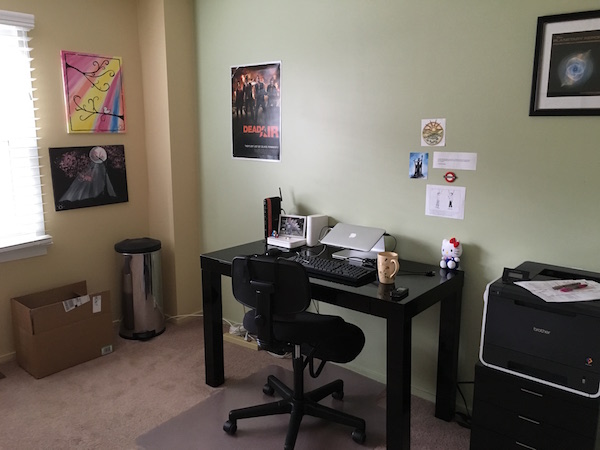Ellis’ Writing and Publishing Toolbox
 Powered by coffee, Hello Kitty, and Left 4 Dead.
Powered by coffee, Hello Kitty, and Left 4 Dead.
Hey again! I thought I’d give you a behind-the-scenes peek at everything that contributes to my production process, from draft to finished book/story.
HARDWARE
A room in my house serves as my dedicated office. Up there you see my desk: MacBook Air, laptop stand, cheap mouse, expensive keyboard that makes neat clicky sounds. And omg COFFEE, two mugs a day. Next to the desk is my laser printer, which comes in handy for printing off drafts and review copies. In the drawers, you’ll find things like staples, envelopes, and oodles of pencils (mostly mechanical) and pens (ballpoint and felt-tip). I also draw with these on occasion.
SOFTWARE
Most of the magic happens on my computer. Here are the programs I use from start to finish. With the exception of Scrivener, these apps are all free to download and use:
Scrivener – This program has spoiled me to the point that I can’t draft things anywhere else. The way it lets me split up, organize, and notate things is unparalleled. Plus it lets me save snapshots of old drafts, which I fall back on from time to time.
OpenOffice – I use this to take my Scrivener draft and create PDFs for paperback interiors and free ebooks. While Scrivener has its own conversion tools, I trust myself more. This program performs really well, and lets you do just about everything Microsoft Word can do. That’s way more than I can say for Pages, which I find unacceptably slow and hobbled.
MacDown – I’m currently experimenting with Markdown to see how well it streamlines my conversion from draft to HTML, important for making ebook files. MacDown happens to be one of many free apps out there for Markdown editing.
Komodo – If I need to do heavy-duty HTML editing, I do it here. This is also the program I use to maintain my website.
Sigil – Great tool for creating EPUB files, once you get past its learning curve. I make ebook files manually because (a) I have a good understanding of CSS and HTML, and (b) I can ensure they’ll come out exactly the way I want at the smallest file size possible. I don’t like crossing my fingers and hoping a compile or conversion will work out. I also don’t trust the cruft that gets added to files in that process.
Epubcheck – Lets me validate my EPUB files. Was quite a helpful troubleshooting tool in the past when I couldn’t figure out why my conversion from EPUB to MOBI was failing.
KindleGen – Lets me convert my EPUB into a MOBI that Amazon will accept. It also gives you compression options to ensure the file size is as small as possible. This is important because Amazon charges you delivery fees every time someone buys your ebook. These fees are dependent on your ebook file size, and can eat into your royalties if you’re not careful!
GIMP – This is what I use for designing paperback and free ebook covers. I have experience with Photoshop and InDesign, so I don’t have much trouble using GIMP. Plus, there are tons of tutorials and docs online in case you’re ever not sure how to do something.
If anyone has suggestions of things I should be using, I’d love to hear about it in the comments!